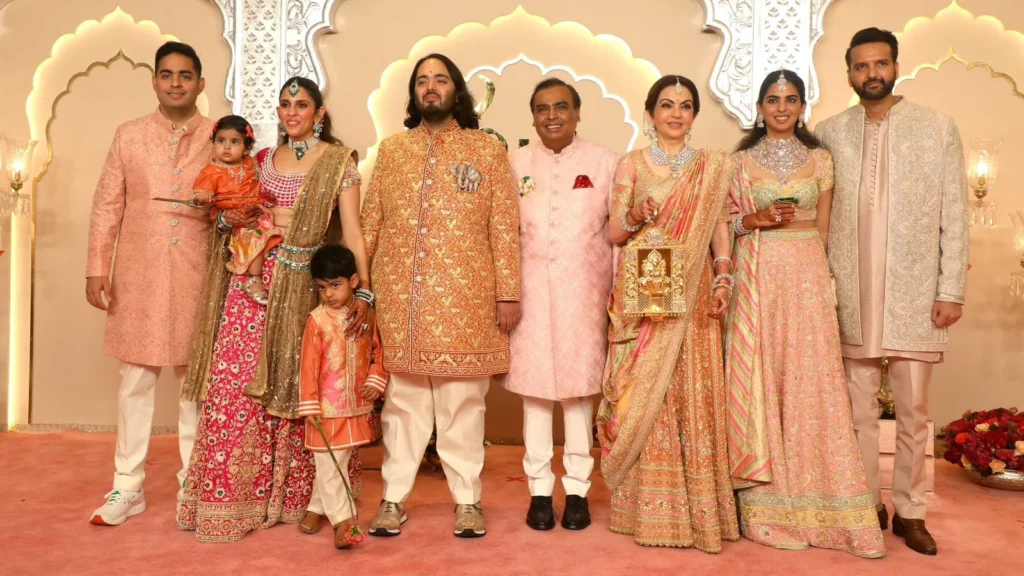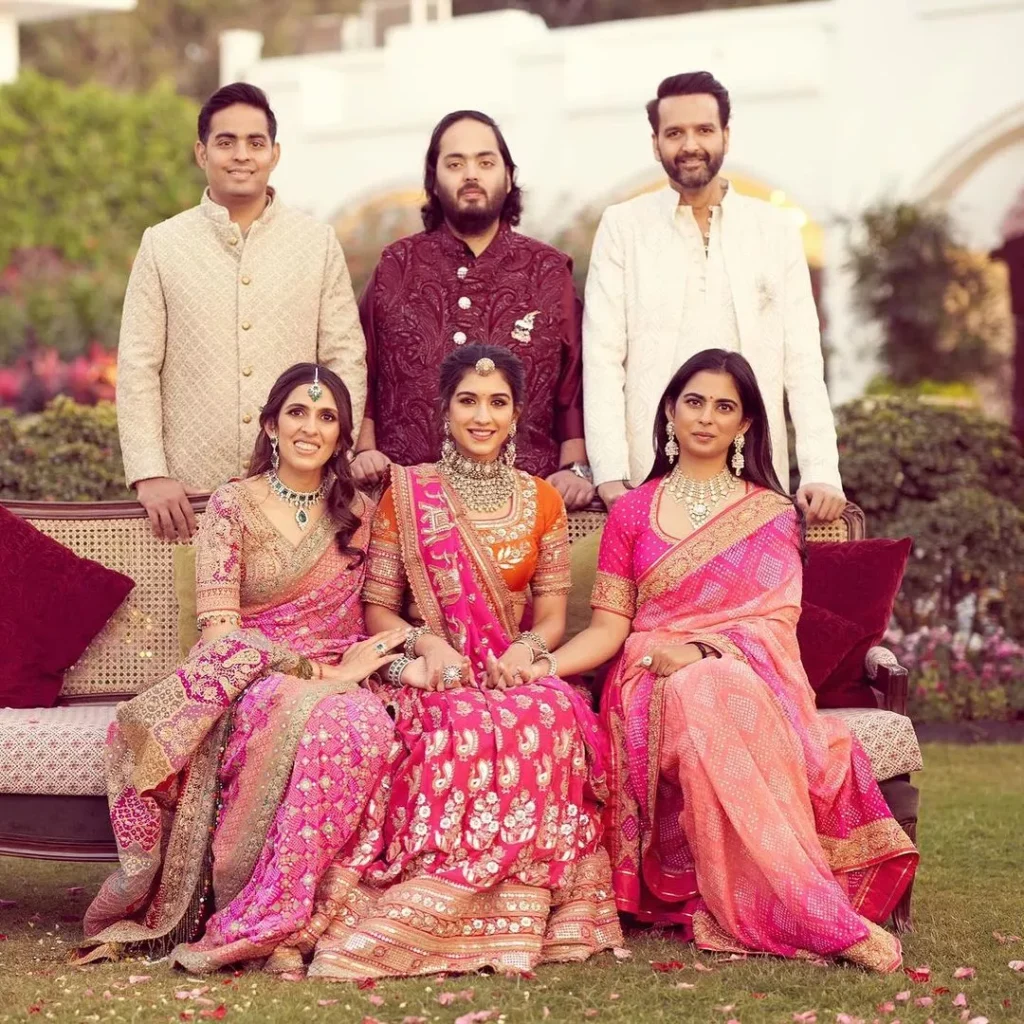The Good:
The wedding of Anant Ambani and Radhika Merchant, often referred to as India’s wedding of the year, showcased the grandeur of Indian culture and traditions on a global platform. The celebration was a testament to the rich cultural heritage of India, with intricate ceremonies, traditional outfits, and elaborate decorations. The event brought together people from various walks of life, including global celebrities like Kim and Khloé Kardashian, former British prime ministers, and Indian sporting legends, thus fostering a sense of unity and celebration.
Moreover, the wedding provided significant economic benefits to the local economy. The influx of international guests and the extensive preparations created numerous job opportunities, boosting local businesses and industries, from hospitality to event management. Renowned wedding designer Preston Bailey highlighted the Ambani family’s commitment to showcasing India’s creative talent, emphasizing the potential for increased global appreciation and demand for Indian artistry.
Additionally, the Ambani family’s charitable acts, such as hosting a communal dinner for over 50,000 villagers and staging a mass wedding for 50 underprivileged couples, demonstrated their commitment to giving back to the community. These acts of kindness not only provided direct benefits to those involved but also set a positive example for others to follow.

The Bad:
Despite the grandeur and positive aspects, the Ambani-Merchant wedding faced significant criticism for its opulence and extravagance, especially in a country where millions live in poverty. Critics argue that the display of wealth was excessive and highlighted the stark contrast between the rich and poor in India. This disparity can foster resentment and highlight the urgent need for wealth redistribution and social equity.
Furthermore, the environmental impact of such a large-scale event cannot be ignored. The wedding generated substantial waste and carbon emissions, with large banquets, elaborate light displays, and extensive travel contributing to the environmental footprint. Ashwin Malwade, co-founder of Greenmyna, a sustainable wedding consultancy, pointed out that an event of this magnitude would emit far more carbon than even the largest Indian weddings, raising concerns about sustainability and responsible consumption.
The involvement of international celebrities and the extensive media coverage also drew attention to issues of privacy and security. The high-profile nature of the event required significant security measures, potentially disrupting local life and raising questions about the allocation of resources.

The Gist:
Anant Ambani, the youngest son of billionaire Mukesh Ambani, married Radhika Merchant in a lavish wedding in Mumbai, attended by global celebrities, former British prime ministers, and notable Indian figures. The three-day celebration included a blessing ceremony by Prime Minister Narendra Modi and concluded with an extravagant reception.
The wedding, held at the Ambani-owned Jio World Convention Centre, featured multiple outfit changes for the couple, showcasing custom-made pieces that celebrated Indian heritage and culture. The event was designed by renowned wedding planner Preston Bailey, who created elaborate floral installations inspired by the couple’s love for animals.
While the wedding was a celebration of Indian culture and provided economic benefits to the local economy, it also faced criticism for its opulence in a country with significant poverty. The environmental impact of the event, due to large-scale banquets and extensive travel, raised concerns about sustainability.

The Take
India’s wedding of the year concluded in Mumbai, as billionaire heir Anant Ambani married Radhika Merchant in an opulent ceremony attended by celebrities, political figures, and business tycoons. The three-day celebration showcased the grandeur of Indian culture and traditions while providing significant economic benefits to the local economy.
The wedding was held at the Ambani-owned Jio World Convention Centre, transformed into a miniature version of the holy city of Varanasi. The couple underwent multiple outfit changes, appearing in intricate, custom-made pieces that celebrated India’s rich heritage. Merchant’s bridal ensemble was designed by Indian label Abu Jani Sandeep Khosla, featuring elaborate zardozi embroidery on silk, while Ambani wore a custom red sherwani by Sabyasachi Mukherjee.

Prime Minister Narendra Modi attended the blessing ceremony, offering well wishes to the couple. The event was designed by renowned wedding planner Preston Bailey, who created elaborate floral installations inspired by the couple’s love for animals. Bailey praised Nita Ambani’s attention to detail and her commitment to showcasing India’s creative talent.
However, the wedding faced criticism for its opulence, especially in a country where millions live in poverty. Critics argued that the display of wealth was excessive and highlighted the stark contrast between the rich and poor. This disparity has raised calls for wealth redistribution and social equity.
Environmental concerns were also raised due to the significant waste and carbon emissions generated by the event. An average Indian wedding typically generates between 1.5 to 2 tons of waste and around 30 to 40 tons of carbon emissions. An event of this magnitude, with extensive travel and large-scale banquets, would emit far more carbon, raising questions about sustainability and responsible consumption.
The Ambani family’s charitable acts, such as hosting a communal dinner for over 50,000 villagers and staging a mass wedding for 50 underprivileged couples, provided some relief from the criticism. These acts of kindness not only benefited those directly involved but also set a positive example for others to follow.

The wedding also provided significant economic benefits to the local economy, creating numerous job opportunities and boosting local businesses and industries. The influx of international guests and extensive preparations required for the event resulted in increased demand for hospitality services, event management, and other related industries.
The involvement of international celebrities and the extensive media coverage drew attention to issues of privacy and security. The high-profile nature of the event required significant security measures, potentially disrupting local life and raising questions about the allocation of resources.
In conclusion, while the Ambani-Merchant wedding was a celebration of Indian culture and provided economic benefits, it also highlighted the stark contrast between the rich and poor in India and raised concerns about sustainability. The event showcased the grandeur of Indian traditions and brought global attention to India’s creative talent, but it also underscored the need for greater social equity and responsible consumption.








































































